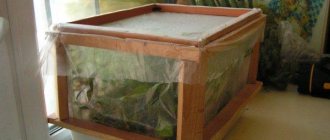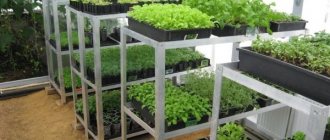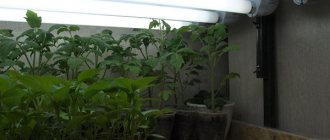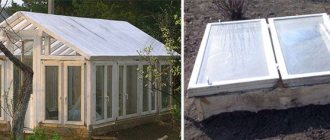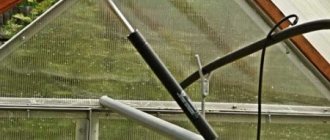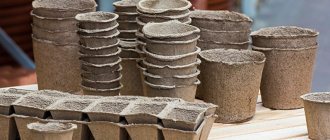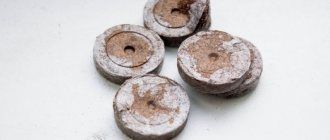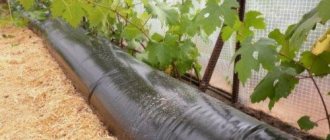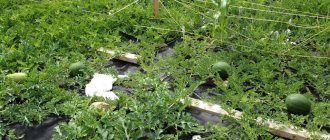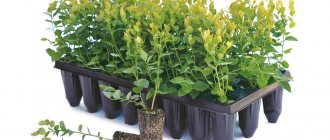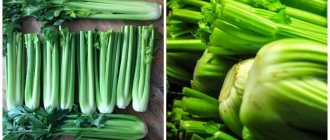Spring is getting closer, and every gardener has a time of new worries related to upcoming work on his summer cottage. One of them, perhaps the most important and troublesome, is growing seedlings. This requires suitable soil, good seeds, humidity and suitable temperature, but most importantly a large space with the necessary level of light. In a city apartment or even a small private house, this is not easy to implement. Special racks for seedlings come to the rescue. We will talk about how to make them yourself in this article.
Basic requirements for racking
A rack for seedlings can be made from various materials, but in any case it should be:
- durable;
- suitable for repeated use;
- convenient, i.e. provide comfortable conditions for caring for plants (it is important to have quick access to seedlings for watering, inspection and loosening);
- having an aesthetically attractive appearance.
The dimensions of the structure can be completely different, but racks with the following parameters are considered universal:
- number of shelves – from 3 to 6;
- the length of the shelves is sufficient to accommodate standard fluorescent lamps (i.e., from 50 cm);
- height between shelves – from 40 to 50 cm;
- the distance from the floor to the bottom shelf is from 10 cm.
Often the bottom shelf is used to store various garden tools or household items.
If you do not plan to keep seedlings on the last shelf, the top of the rack can be left open by installing front and rear horizontal supports instead of the top shelf. They will not only support the entire structure, but will also be an excellent place for attaching lighting elements.
Advantages and disadvantages
The advantages of a homemade rack include:
- optimal size and height of the structure;
- the ability to make shelves with the necessary parameters for each type of seedling;
- You can install mirrors and any type of lighting on homemade shelves;
- you can use any materials, make collapsible or stationary racks;
- the cost of assembling a rack is several times lower than purchasing a finished product.
Disadvantages of a homemade structure:
- Not every amateur gardener can make a high-quality and durable rack;
- the need for free space does not disappear;
- To store a disassembled rack, a lot of space is required.
Despite the disadvantages, users prefer homemade designs. They are much cheaper and have optimal sizes, which becomes the determining argument. Ready-made racks are purchased only due to necessity and the inability to make homemade structures.
Material selection
The rack must be strong, waterproof and durable, which should be taken into account when choosing a material. Let's take a closer look at the possible materials for making a rack:
- Tree . One of the most popular materials, because it breathes, looks natural and beautiful, but has a significant drawback - it absorbs moisture. In this regard, when choosing a breed, preference should be given to hard varieties, since they absorb moisture worse than others. These include maple, ash and oak. In addition, it is worth using special impregnations that help solve the problem of wood getting wet.
- Metal . It is better to choose stainless steel as it will prevent corrosion. You can use profiles and even metal pipes as racks, and the shelves can be made from sheet metal or durable mesh. In general, iron structures are durable and quite reliable, but they will be more expensive and will require significant effort in the manufacture of the rack, since working with metal requires certain skills and the presence of expensive equipment.
- Plastic . This material has many advantages - it is durable, easy to wash, and does not absorb moisture. When making shelving, you can use not only plastic sheets, but also pipes.
- Plexiglas . From this material you can assemble a transparent original design that looks stylish and modern. Plexiglas comes in different colors, so you can assemble a rack with multi-colored shelves.
- Plywood . It is easy to process, but gets wet quickly, so it is not the best choice when making racks for seedlings. However, if you still use plywood, then you should prepare several pieces of film or oilcloth to wrap the shelves with it, otherwise their rapid deterioration is inevitable.
The choice of material depends on financial capabilities and engineering and design decisions, however, if the choice is between plywood, plastic and plexiglass, then it is better to give preference to the second or third option. Such materials have a long service life and do not require any coating to protect them from moisture.
Having prepared the material, you should also acquire the necessary tools for constructing the rack, namely: a saw (regular or end-face), drill, screwdriver or regular screwdriver, etc.
Useful tips
LED lamps are not suitable for illuminating seedlings; they do not provide the range of luminescence necessary for plants. Fluorescent lamps are suitable for already mature seedlings. They are less safe to use due to the long glass body. Therefore, the lighting on the housekeeper should be done on flexible hangers and under no circumstances should it be rigidly attached to the surface of the shelf. Otherwise, under load due to the weight of the seedlings, the surface may bend and break the glass.
Halogen lights work well, they give a full spectrum, but they are installed above the seedlings in reflectors and at a distance of at least a meter from the seedlings
Types of structures
For seedlings, you can assemble the following types of structures:
- Stationary . A suitable option for a specially equipped room for growing plants, since the structure cannot be disassembled, but is fixed in several directions. Its advantages are that it is reliable and durable.
- Collapsible . If free space is limited, then it is better to choose such a design, since it is convenient to move, and after growing seedlings it can be completely removed.
- Window . This design is installed on the windowsill in the window opening. This design is suitable for germinating a small number of seedlings. Window shelving is often used to grow herbs for the table throughout the year.
Each design has its own advantages, so it is better to make your choice based on your own preferences and financial capabilities.
Varieties
Racks are divided into stationary, mobile, and collapsible.
Stationary racks are attached to the wall or ceiling. This adds strength and durability to the entire structure. Suitable for large apartments, where a bulky rack will not disturb the residents. After the plants are “moved” into the garden, it is used to place household utensils, flowers, and toys.
The reliable design of the stationary rack will support a large number of seedlings and last for several seasons
Mobile racks are equipped with wheels; the racks can be moved around the room and rotated. There is no need to unload the contents of the shelves if you need to place the seedlings in another part of the room.
The use of wheels allows access to seedlings from all sides due to the rotation of the structure
Collapsible racks are easy to use. They can be disassembled and stored until the new season.
The design of perforated corners allows you to change the height of the shelves and completely disassemble the rack
The size of the rack is selected depending on the area of the room allocated for seedlings. Often the gardener has only window sills at his disposal. The height and width of the rack in this case is limited by the size of the window opening. If it is possible to allocate part of the room to prepare for the gardening season, then you can equip a rack with a large usable area.
The frame of the rack is made of metal or wood. The original option is a frame made of plumbing pipes. Wood, plastic, glass or metal are used to make shelves. If the purchased rack is not equipped with lighting, then purchase lamps and install lighting.
Wooden rack for seedlings
If you are planning to make a shelving unit from wood, you will first need to draw a sketch of it so that you do not forget what dimensions to adhere to. Here is an example of a suitable diagram:
It is better to make shelves from timber in the form of a longitudinal lattice. They will be stronger than plywood shelves, although the structure will be more bulky and heavy.
After preparing the sketch, you need to collect the following materials and tools:
- wooden beams for racks with a section of 45x60 mm (2 pieces of 3 m each, you can immediately ask to cut them into 1.5 m sections);
- wooden beams for crossbars with a cross-section of 20x60 mm (2 pieces, 2 m each, you can immediately ask to cut them into 50 cm pieces);
- wooden board for shelves with a section of 22x100 mm (one shelf takes 5 pieces 75 cm long, then for all 4 shelves you need 4-5 boards of 3 m each);
You can save on boards for shelves if you lay them not end-to-end, but at a short distance from each other. There will be a shelf in the form of a wooden lattice.
- saw;
- screws, nails;
- chisel;
- hammer;
- wood glue;
- roulette;
- pencil.
After preparing all the necessary materials and tools, you can proceed directly to the construction of the rack. This process essentially consists of two main stages - cutting parts and assembling them. We will consider each stage separately.
Cutting parts
The timber purchased from a hardware store must be cut taking into account the following parameters:
- the length of the bars for the manufacture of supporting parts of the rack (racks) is 1.5 m each;
- the length of the bar for the crossbars is 50 cm;
- the length of the shelf boards is 75 cm.
On each beam you will need to measure the required length, draw a line and cut along it using a miter saw or a regular saw. To save overall time, it is advisable to use a circular saw or jigsaw. Based on the cutting results, you need to obtain the following elements of the future design:
- 4 supports 1.5 m long;
- 8 short timber crossbars;
- 15-20 boards for shelves.
To further strengthen the rack, you can prepare bars that will need to be screwed to the finished structure diagonally at the back wall.
Assembly
The prepared boards need to be connected like a construction set to get the finished product. You must act in this order:
- Mark with a pencil where the groove for the crossbar will be located, attaching it to the support block:
The first crossbar should be located at a distance of 23-24 cm from the edge of the support beam, and the subsequent ones - 40 cm from each other. Measurements should be taken from the end of the support beam, which is in contact with the floor. This will ensure that the shelves are at the same height. - At the marking sites, first make cuts taking into account the thickness of the crossbar, and then cut out the grooves using a hammer and chisel.
Please note that the crossbar must be recessed into the groove. - Secure the first cross member between the two support bars by driving it into the groove with a hammer (dimensions in mm in the photo).
It is recommended to pre-treat the fastening points with wood glue and additionally secure them with self-tapping screws.
- After 40 cm, fix another crossbar, and behind it two more (the last crossbar will be at the very top edge). The result should be a kind of staircase.
- Prepare the second side of the structure as described above.
- Lay the boards that will make up the shelves between the two support posts. Secure them to the crossbars using self-tapping screws or nails.
- Cut corners in the end boards so that the support beams fit into them.
- Create the two top shelves in the same way.
- The top shelf can be made longer.
The finished structure will look like this:
If the joints were not treated with glue during assembly, such a rack can be easily disassembled by simply unscrewing the screws. In order not to waste time on disassembly, after growing seedlings, the rack can be moved to another place and used to store books, tools, jars with preparations, etc.
How to make a rack yourself?
First of all, decide on the size of the rack. Everything here is individual and depends on your desires and capabilities.
Don’t forget that the seedlings will grow; take this into account when calculating the height of the shelves. If you plan to install lighting, make a reserve in length and height for the lamps: the lamp should protrude beyond the edges of the shelf so that the lighting is uniform, since fluorescent lamps usually heat up more strongly at the edges than in the middle.
Standard parameters of a rack for seedlings with 3-6 shelves:
- structure height – 1.2-1.8 m;
- shelf length – 1-1.2 m (adjusted to the length of the installed lamps or the width of the window, if it is a window rack);
- shelf height – 40-60 cm (calculation formula: container height + maximum seedling height + lamp height + 10 cm reserve);
- shelf width – 20-70 cm (boxes with seedlings can be placed perpendicularly on a wide shelf).
Shelving material. A stand for seedlings can be made from almost any material. Metal (stainless steel, perforated tubes, metal sheet), wood (timber), plastic (plastic pipes, plexiglass) are suitable. The strength of the structure depends not so much on the material as on the quality of workmanship.
Backlight. Typically, fluorescent lamps are mounted along the center of the shelf. Experienced summer residents claim that for one shelf 40-50 cm wide, a double lamp 2x18 W is sufficient. A wider shelf (60-70 cm) will require 3 lamps. At night, seedlings do not need to be illuminated. The best option is to turn on the lamps in the morning and turn them off before you go to bed.
In some cases, seedlings can be given a “dark night” even during daylight hours by covering the rack with a light-proof curtain. This is done in order to slow down growth if the seedlings begin to stretch.
To adjust the intensity of the illumination, the lamp can be attached to chains and hung on hooks built into the shelf. Depending on the stage of seedling growth, the lamp is raised to the desired height.
There are no strict rules regarding the design. The algorithm of actions is as follows:
Installation of the rack base. Manufacturing of ends, shelves. Installation of shelves and lamps.
For a visual master class with recommendations on how to make a metal rack for seedlings with lighting with your own hands, watch the video:
A durable rack with proper proportions and “properly” installed lighting is the key to successfully growing seedlings at home.
Metal structure
This version of the rack is made of a metal corner. It is lightweight, which is its undeniable advantage.
Before you begin assembly, you will need to prepare the following materials and tools:
- metal corner measuring 40x40 mm;
- boards for shelves;
- miter saw;
- self-tapping screws for assembly;
- metal drill;
- electric drill for preparing holes for fasteners;
- roulette;
- marker for marking.
The amount of material needed should be calculated based on how high the racks will be and how long the shelves will be.
Having prepared everything you need, you can cut the metal and begin assembling the rack.
Metal cutting
Cut elements of the future design from a metal corner:
- 4 racks 1.5 m high;
- 4 crossbars 50 cm each;
- 4 shelves, the length of which must correspond to the desired length of the rack.
The length of the rack must be determined taking into account the location where the structure is planned to be placed.
Assembly
The rack is assembled according to the following instructions:
- Drill holes in the places where the elements are supposed to be connected.
- Fasten the parts with self-tapping screws (or you can use rivets).
- Cut the boards using a saw into the required size to cover the space between the supports of each level and create shelves.
- Place the shelves between the rails to create a finished shelving unit.
How to assemble a shelf rack using only metal profiles is shown in this video:
Manufacturing procedure
Assembling the rack is not particularly difficult, but requires preliminary selection of the material and type of lighting. The most popular option is a wooden rack, which does not require the use of complex tools and can be made quite quickly even by inexperienced people.
Let's look at the procedure:
Tools and materials
To assemble the racks you need to prepare:
bars 45 × 45 mm for the manufacture of vertical supports (racks);
bars 30 × 60 mm for making crossbars;
self-tapping screws 50 mm long;
plywood for making shelves;
hacksaw, electric saw or jigsaw;
ruler, square, tape measure;
electric drill with a set of drills.
Only the most necessary tools and materials are listed. You may need other accessories during the assembly process.
Manufacturing
Procedure:
- Racks are cut from a 45 × 45 mm block (4 pieces per rack). Their height is calculated by multiplying the distance between the shelves by their number, plus the height above the floor;
- Cross members are cut from a 30 × 60 mm block (two for each shelf, plus two short cross members between the posts on the short side);
- On the racks, using a ruler, a pencil and a square, markings are made along which the crossbars are installed;
- It is recommended to strengthen the assembled rack with metal window corners installed on the rear side of the structure. They will provide stability and protect the rack from swinging to the sides.
At this point, the assembly of the rack is considered complete. However, the final finishing and installation of lighting remains.
The final coating (this is not a mandatory element, but it will not be superfluous) is applied with a regular brush. You can paint the rack or varnish it.
Installation of lighting is carried out based on the design of its elements. Phytolamps are produced in the form of linear elements, which only need to be fixed in the right place under the shelves.
LED strips can be attached to their own adhesive layer, or use a special aluminum profile. All this work is not difficult, requiring only accuracy and attention.
Assembly from other materials
The use of other materials does not complicate the assembly process too much, but requires the use of other connecting elements.
If metal guides are selected, self-tapping screws with a drill tip are used to connect the parts.
For the plastic frame, special fittings are used - tee or double corners.
The process of assembling such racks differs little technologically from that described above. The same assembly scheme, only for plastic pipes, racks are not needed, but short sections are used. They determine the height of the shelves above each other. For shelves, sheet materials are also used, which are coated with varnish or paint.
Window sill rack
The problem of limited space can be solved by a window rack on which you can keep a large number of seedlings.
To make such a rack you will need:
- wooden beam with a section of 20x20 mm;
- a sheet of plywood (if you decide to make the shelves from it);
- jigsaw;
- screwdriver and screws or nails and hammer;
- roulette;
- pencil.
Having prepared everything you need, you can start making the rack:
- Beam into pieces mode: for support you will need 4 bars of 80 cm in length, for crossbars - 4 bars of 27 cm in length.
- Mark each support bar. We measure 5 cm from the top edge, and 37.5 cm from the bottom.
- To assemble the side part of the structure, it is necessary to nail two crossbars to two support bars in the places where the mark was made. For structural stability, a profile can be attached diagonally to each supporting structure.
- Assemble the second side part of the structure using the previously indicated method.
- Nail between the sides of the shelf. They can be made from the same timber or cut from a sheet of plywood. The shelves of the rack can be not only wooden, but also glass, but for reliability they should be secured with adhesive gaskets.
- If necessary, you can attach backlight lamps under each shelf.
The diagram shows standard dimensions that can be adjusted taking into account the width and depth of a particular window opening.
In what places are boxes and trays with seedlings usually placed:
- on the windowsill;
- on a well-insulated loggia;
- inside the room, additionally providing the structure with artificial lighting.
What requirements must be put forward for a rack of seedlings?
The rack must be strong and reliable. That is, to withstand heavy loads. Also, this attribute must be resistant to moisture. It is good to transmit the sun's rays if we are talking about an attribute without backlighting. And of course, have an aesthetically attractive appearance.
When the question concerns the number of shelves on a rack, there can be only one answer: it all depends on the wishes of the person and the capabilities of his space.
The number of shelves can start from 3 and above. The width of the shelf should not exceed 70 cm, and the height should reach about 50-60 cm.
Before you start making a rack, you need to decide on the size, placement and materials that you will use.
How to make a wooden rack for seedlings with your own hands
This rack is easy to make, and it can be placed anywhere, not necessarily next to the window.
Assembly steps:
- First of all, we make the side parts of the rack. To do this, we nail 4 crossbars to two bars at a distance of 50-60 cm from each other. The very first one will hold the bottom shelf, so it needs to be attached 10-15 cm from the bottom edge of the bars.
- We reinforce each opening with a profile that strengthens it diagonally.
- We make the second end in the same way as the first.
- Making shelves. Between the left and right posts of the shelf we nail 4 wooden blocks across. And so 3 shelves.
- At the very top there will not be a full-fledged shelf, but simply 2 crossbars for attaching lamps.
- Now you can connect all the elements. The simplest shelves made of wooden slats are placed on the side bars.
- Then you need to cover all internal surfaces with foil or insulation with a reflective layer inside out, so that this layer reflects the light of the lamps.
- Attach two fluorescent or LED lamps above each shelf.
The advantages of such a rack: practicality, functionality. Can be rearranged to any place.
Disadvantages of such a rack: you cannot move the shelf higher or lower, but the seedlings need this.
How to make a rack with rearrangeable shelves for seedlings with your own hands
This rack is interesting because you can adjust both the height of the shelves and the height of the lamp hanging. The rack is attached directly to the wall.
Before work, it is advisable to prepare:
- 3 shelves. Purchased ones (furniture panels) or homemade ones will do;
- 2 shelving guides with single-row perforation;
- brackets;
- dowels, screws.
Assembly steps:
- Fix the guides along the wall to the ceiling at a distance of 50-70 cm from each other. This distance should correspond to the width of the existing shelves.
- To attach each shelf, attach the brackets to the guides at the height you plan for the shelves.
- Just under the ceiling, attach 2 more brackets to the guides for hanging the lamp. The remaining lamps are suspended above each shelf.
- It is better to cover the wall, which has become the inner surface of the rack, with foil cardboard or just white cardboard, which will reflect light. Next we install the shelves.
The advantages of such a rack are its ease of manufacture. If desired, it can be supplemented with a timer that will turn the light on and off at a given time.
Rack made of plastic pipes
This type of structure is assembled like a metal rack. It has a low specific gravity, so it is easy to move around the room.
To make a rack you will need:
- PVC pipes;
- hacksaw;
- tees (4 pcs.);
- corners (12 pcs.);
- corner crosspieces (4 pcs.);
- roulette;
- marker for marking.
You can assemble the rack according to the following instructions:
- Cut 4 long pipes for supports (180 cm each), 6 crossbars (50 cm each), 4 crossbar pipes (150 cm each) and 4 “short” pipes 30-40 cm each.
- First take one crossbar 50 cm long and put two tees on it at an equal distance from each other. Do the same with the second cross member.
- Take 4 pipes of 180 cm each and cut each in half (i.e. 90 cm). Connect the two parts together using a corner cross. Connect the rest as well. There should be 4 such elements. Place two elements parallel to each other.
- First, insert one assembled cross member into the crosspiece, forming the letter “H” from the pipes. Do the same with the second pair of elements. The result was two separate “H” shaped structures.
- Take two more crossbars 50 cm long. Using corners, secure one at the top and the second at the bottom of the H-shaped structure. You will get a new figure - a figure eight, like on an electronic watch. There will be two such parts. These are vertical supporting walls. Place them parallel to each other.
- Insert a crossbar pipe into the last free holes of the crosspieces. This way the two side support walls will be connected to each other and will be able to stand stably.
- The resulting frame is only missing a “shelf”. Using angle brackets, secure one “short” pipe at each end of the crossbar pipe. The result will be a bracket-shaped structure. There will be 2 of these shelf parts. Insert them into the remaining free holes of the tees, placing the shelf parts parallel to each other.
- Place the pots with seedlings on the “shelf”. You can install a pendant lamp on top, firmly securing it to the side posts.
You can put a sheet of plywood on the bottom of the shelf if you are using pots, but it is better to just choose tall cassettes or spacious boxes for seedlings.
How and from what to make it?
Materials for making a flower rack can be different:
- A glass shelf looks light and casual.
- It will be convenient and practical made of plastic.
- Wooden shelves will add some zest to the interior.
- The metal structure will be durable and reliable.
Each material has its own characteristics and subtleties in work. It is the material from which the flower shelf will be made that will determine the design of the product.
DIY wood rack
Wood is a very popular material for making flower shelves. Making a rack is not difficult if you follow the step-by-step instructions:
- First, the boards are sanded and treated with antifungal materials.
- Varnish or paint the wood in the desired tone.
- Measure the data of the window opening.
- Two lateral support planes are made. They must match the dimensions of the window in width and depth, and be five centimeters lower in height.
- Determine the number of shelves on the rack.
- Screw the corners into the structure.
- Place the rack on the window.
- Installing shelves.
Additionally, shelves on a wooden rack are covered with foil on both sides. In addition to protection from moisture, this will provide additional lighting for plants.
Collapsible metal structure
If the windows have wooden window sills, then you can make a shelving unit from metal. A plastic window may not support the weight. The exact amount of material depends on the size of the window to which the size of the structure is adjusted.
- The size of the structure must be calculated so that there is a distance of 5 cm between the frame of the product, the side walls of the window and the glass.
- A maximum of three shelves can be placed.
- Two rectangles are assembled from the profile - these will be the side elements of the frame.
- They retreat 10 cm on both sides and attach jumpers; they will strengthen the side frames.
- Having placed the rectangles in a vertical position, connect the upper and lower corners with jumpers.
- Attach holders for shelves; it is better to place them on bolts - this will allow you to change the height of the shelves if necessary.
- The holders are made of steel angle. The blanks are made according to the width of the frame. Holes are drilled at the ends of the corners.
- The drilled corners are connected with bolts to the side posts of the frame.
- Paint the rack. The shelves are cut to the size of the frame and placed on holders made from corners.
If the shelves are afraid of moisture, you can put rubber mats on them or wrap them with film.
Made of glass with forged corners
If you want to make a more elegant design for the window sill, you can make a glass shelf. If the window is wooden, then it is easy to do.
- You need to take tempered glass and forged corners.
- Screw them to the side of the window and place a sheet of glass on them.
Made from polypropylene pipes
A flower shelf on a window made of PVC water pipes looks unusual. If desired, you can use different pipe diameters. Assembling the frame is similar to a construction set. You will also need various connections (fittings):
- crosses;
- knee;
- tees.
A more reliable pipe connection is ensured by soldering. They also use glue or detachable fittings.
The last option is the simplest; it allows you to disassemble the structure as needed.
- The base of the rack is a rectangle.
- The side walls are assembled first.
- The wall consists of pipes connected by crosses and assembled in the form of a rectangle.
- The side walls are connected to each other using pipes and crosses. The length of the pipe is selected according to the size of the window.
- If necessary, you can strengthen the frame with additional racks - spacers between the shelves.
- The shelves are fixed at a certain height into tees mounted on the side posts of the rectangles.
- The shelves are cut out of plywood, chipboard or other suitable material.
Such a rack looks harmonious on a plastic window, and its light weight will not harm the window sill.
If you want to decorate the rack, you can put tempered decorative glass on the shelves.
Homemade pallet rack
If the seedlings will be grown in a small apartment, the problem of placing containers with plants can be solved using a narrow vertical pallet structure mounted on one of the walls. To make it you will need:
- pallet (cargo box);
- wooden beams (4 pieces, 3 m each);
- wooden slats;
- hammer;
- nails;
- pencil;
- roulette.
You can assemble the rack according to the following instructions:
- We are making a three-bay rack. Cut the timber 1.5 m long. You will get 8 parts.
- Cut 18 slats as long as the width of the pallet.
- Take two bars and place them parallel to each other. Step back from the top as much as the thickness of the pallet (about 10 cm). Fasten the slats to the bars with nails so that you get a structure similar to a ladder. Pallets will be installed on these slats as shelves. The distance between the shelves should be about 40 cm.
- Place the pallets on the slats. You can secure them with nails or put them on wood glue.
Why use shelving
Before arranging a window sill, you need to understand for what purpose the rack or shelf is used to place pots and other containers with seedlings on it.
If you are an avid gardener or summer resident, then you know how and where to grow seedlings.
The main condition for good growth is the optimal amount of light, humidity and temperature.
It is not for nothing that window sills turn out to be the most practical and functional place for such tasks.
Selecting a lighting fixture and installing backlighting
If you plan to place the rack in a fairly well-lit place, then you do not need to install additional lamps, otherwise they will still need to be installed to guarantee the seedlings the necessary daylight hours.
The lamps must provide bright light, but at the same time emit a minimum of heat, otherwise the seedlings can get seriously burned. In this regard, any lighting fixtures except incandescent lamps can be used for lighting. Here are the best options:
- High pressure sodium lamps . These lamps emit an orange-yellow glow that promotes seedling growth. In addition, it does not irritate human eyes, so such lamps can be used in residential areas. Their disadvantage is their high cost and the need to use a power regulator when installing them.
- Phytolamps . Although the spectrum of such lamps is good for plants, it is dangerous for human eyes. When installing, they need to be adjusted so that the light hits the seedlings from above and from the sides. The distance from the lamp to the tops of the plants should be at least 10 cm.
- Fluorescent lamps . Such lamps produce cold light, which lacks the red component of the spectrum. They need to be installed at a distance of 30-60 cm from the seedlings. In addition, to ensure uniform heating of the plant, the lamps should protrude 5 cm from the edge of the shelves.
- LED bulbs . Plants that are illuminated by such lamps produce a larger harvest, so they are used more often than other options. In addition, such lamps consume little electricity and also combine the spectra most needed for plants - blue and red.
Since LED lamps are in greatest demand, let’s look at installing the backlight using them as an example. In an electrical goods store, you need to purchase lamps whose length corresponds to the size of the rack (or rather, the length of the shelves).
At the same time, it is extremely important to follow safety precautions - do not leave exposed electrical wires in the public domain, and even turn off the electricity during preparatory work.
Required materials and tools:
- red and blue diodes on the tape;
- glue “Moment” (transparent);
- plastic base or plinth with cable channel;
- screwdriver and screws;
- switch;
- plug and electrical cord;
- insulating tape;
- reflectors.
Instructions for installing the backlight are as follows:
- Attach a chain of LEDs to a plastic base.
- Connect the tape to the switch, and from it stretch a wire with a plug to the socket. If you plan to pass electrical wiring through metal corners, then you need to drill holes in them. Of course, you can take a simpler route - carefully distribute the wire along each metal element.
- Secure the base with tape to the bottom of the shelf. To do this, you can use transparent Moment glue.
- Attach mirrors or sheets of foil to the sides of the rack to reflect light.
If the shelves are made of plexiglass, then through them the light will fall unhindered on the seedlings, which is an additional advantage of this design.
In the following video you can clearly see how LED strip lighting is installed in a finished plant rack:
To grow healthy and strong seedlings, it is imperative to provide the seedlings with sufficient heat and light. A favorable microclimate for them can be created using racks for seedlings, which will also help solve the problem of lack of free space. You can make similar designs yourself using the above ideas, diagrams and instructions.
0
0
Copy link
Choosing lighting for seedlings
To achieve the desired effect, you need to take a responsible approach to purchasing a special lamp. Fluorescent lamps have the least benefit for plants, so preference should be given to photoluminescent lamps, which provide softer and closer to natural lighting.
In addition, it is recommended to use a reflective screen to enhance the necessary impact on young shoots.
Lighting for seedlings should also be selected taking into account the required growing conditions in the natural environment.
It follows from this that lighting should not be around the clock, otherwise the seedlings will become excessively elongated, become pale and will be more susceptible to disease. Any plant needs a period of rest, usually at night.
The duration of use of additional lighting will largely depend on the location of the containers with seedlings. Preference should be given to southern windows, then the phytolamp will be used only to extend daylight hours in the morning and evening hours, as well as to maintain the required degree of illumination on cloudy days.
If the seedlings are placed on northern windows, then the duration of continuous switching on of the lamp will be about 12-14 hours.
Checking whether the seedlings need additional lighting is simple: turn on the lamp - if the room becomes significantly lighter, then additional lighting is necessary.
Assembly. To work you will need:
- long and short self-tapping screws;
- from 2 to 6 fluorescent lamps;
- wire with plug and switch.
Attach a fluorescent lamp, previously connected to a wire, to the bottom of the shelves. The lamps are placed at a distance of at least 30 cm from the seedlings, so that the light is distributed evenly.
You can create many different designs, but remember that the shelf located at the far end of the room must be complemented by a light source.
Deciding on design and construction
The rack consists of several shelves connected by longitudinal and transverse frame slats. If the space of the room allows, it is better to choose a stationary option in the form of a cabinet. Dimensions should be calculated based on the dimensions of the free wall where the structure is planned to be installed.
Wood products tend to deteriorate, especially in a humid environment. To do this, they need to be painted and the coating periodically renewed. Plastic models are strong and durable. Metal shelving is easy to use. Frames are often equipped with hooks or other fasteners, with which the height of the shelves can be easily adjusted. If necessary, shelves are removed or added.
In a spacious room you can install round or oval racks. This model looks aesthetically pleasing and original. There is access to plants from all sides.
Additionally, the structures are equipped with lighting. Lamps are selected depending on the needs of the crops being grown. Lamps are:
- sodium;
- luminescent;
- LED;
- incandescent lamps.
Phytolamps with LEDs are suitable for any crops. They contribute to the harmonious development of plants. To optimize the temperature in greenhouses, incandescent lamps are often chosen.
Having decided on a suitable option, you should study the models offered by manufacturers. If there is no suitable one among them or its cost is too high, there is always the opportunity to make the rack yourself.
